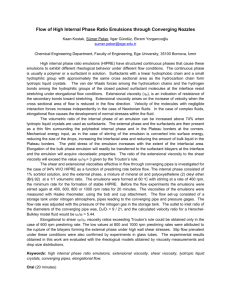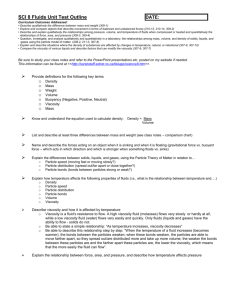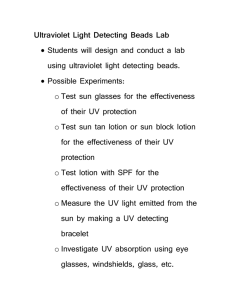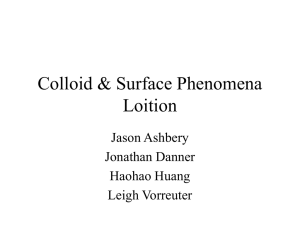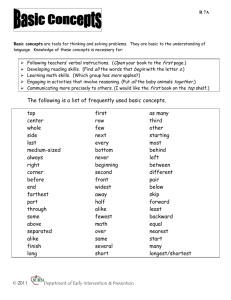moisturizing lotion
advertisement
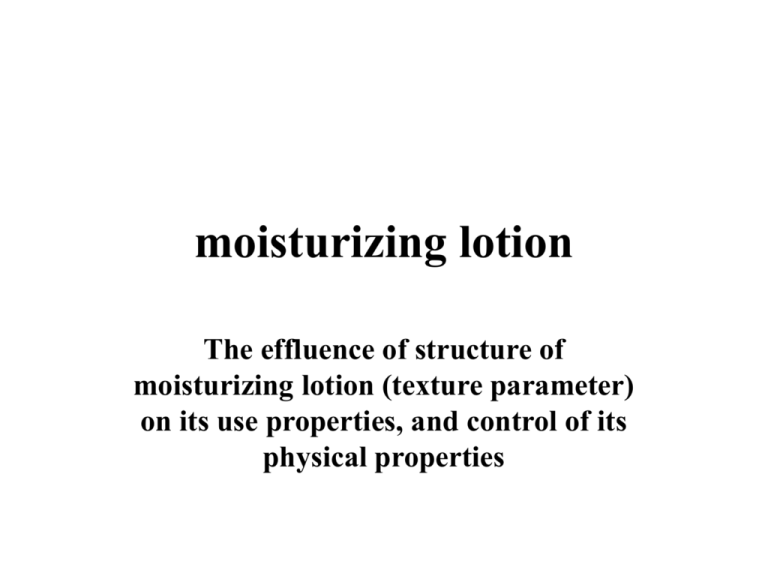
moisturizing lotion The effluence of structure of moisturizing lotion (texture parameter) on its use properties, and control of its physical properties The effluence of structure of moisturizing lotion (texture parameter) on its use properties, and control of its physical properties • 1. Factors influencing the lotion physical parameter • 2. The effects on the behavior of lotion during lotion processing Table 1. Texture profile Mechanical characteristics Primary parameter hardness Secondary parameter Popular terms Soft→firm→hard Cohesiveness Crumbly→crunchy→brittle viscosity Thin→viscous elasticity Plastic→elastic adhesiveness Sticky→tacky→gooey Geometrical characteristics Particle size and shape Particle shape and orientation Gritty, grainy, coarse, etc. Fibrous, cellular, crystalline, etc. Other characteristics Moisture content Fat content Dry→moist→wet→watery Oiliness greasiness oily greasy Table 2. texture profile parameter used in the skin care product evaluation Stage of evaluation Skin care product attribute and definite Texture profile parameter PICK-UP, product removed from container, product poured or squeezed from bottle onto fingertips, or product lifted from jar with forefinger THICKNESS-perceived denseness of product. Evaluated as force required to squeeze between thumb and forefinger. Rated as thin-medium-thick. Or: CONSISTENCY-perceived structure of product. Evaluated as resistance to deformation and difficulty of lifting from container. Rated as lightmedium heavy. Viscosity for lotions RUB-OUT (application), spread of product over and into skin with fingertips using gentle circular motion at a rate of two rub per second for a specified period of time, depending on the product. SPREADABILITY-ease of moving product from point of application over rest of face. Evaluated as resistance to pressure. Rated or described as: ‘slips’-very easy to spread ‘glides’-moderated easy ‘drag’-difficult to spread ABSORBENCY-Rate at which product is perceived to be absorbed into skin. Evaluated by noting changes in character of product and in amount of product remaining (tactile and visual) and by changes in skin surface. Rated slow-moderatefast. Viscosity, cohesiveness, springiness, gumminess, adhesiveness Other characteristics –(oil and water content of product) AFTER-FEEL (and appearance), evaluation of skin surface with fingertips, visually and kinesthetically immediately after product application and possible at varying intervals thereafter. AFTER-FEEL – Type and intensity of product residue left on skin; changes in skin feel/ Product residue is described by type, i.e. film(oily or greasy), coating(waxy or dry), flaky or powdery particles; the amount of such residue is identified as slight-moderate-large. Skin feel is described as dry (taut, pulled, tight); moist (supple, pliant), oily(dirty, clogged). Other sensations are also noted and identified where applicable, i.e. clean, stimulated, irritated, etc. Other characteristics(oil and water content) Geometrical characteristics-(gritty, powdery, etc.) 1. Factors influencing the lotion physical parameter • (1). THE EMULSIFIER The emulsifier frequently is the most important role in the emulsion in producing the characteristic flow properties. In dilute emulsions this is more evident because when the concentration of emulsifier is varied, the effects of change in particle size and particle size distribution of the disperse phase on the viscosity of the emulsion are not as big as the change in the viscosity of the continuous phase brought about by the emulsifier. Mixed emulsifiers can provide desirable flow properties (used to thicken lotion, see also table 2) and to reduce cream of lotion. (2) THE DISPERSE PHASE • There are many parameters related to the disperse phase or internal phase that exert rheological changes in emulsions, including: nature of the oil; viscosity of the oil; particle size; particle size distribution; and particle shape. Particle size and particle size distribution also depend on the emulsifier concentration. • The nature of the oil in O/W emulsion exerts its effect on the emulsion via its interaction with the emulsifier. The viscosity of the aqueous medium and the particle size distribution are related to differences in the state of aggregation of the globules. (2) THE DISPERSE PHASE • The mean particle size and particle size distribution can exert profound effects on the rheological parameters of an emulsion. The viscosity of dilute O/W emulsions are influenced by mean particle size variation of 3 to0.7 microns, but in concentrated emulsions the product of relative viscosity and mean particle size did not change if the distribution of particle size about the mean value was not very wide. (3) THE CONTINUOUS PHASE • The rheological behavior of a lotion is most often determined by the rheology of the continuous phase. The rheological behavior of the continuous phase of O/W emulsions is frequently controlled by the use of hydrocolloids, which have been already been discussed. The rheological behavior properties of the emulsion, in turn, are dependent on the stability of the hydrocolloidal system (4) PHASE VOLUME RATIO • The rheological patterns of dilute emulsions are often markedly different than those for concentrated emulsions. Therefore, it is useful to have information concerning the viscosity dependence on the phase volume ratio in both areas. Generally, it has been found that the rheological parameters of an emulsion increase with crease in the phase volume ratio. It is expected that the limit of φ before inversion occurs will vary depending on the characteristics of the system and, in particular, the nature of the emulsifying agent and its solubility in the continuous phase of the emulsion 2. The effects on the behavior of lotion during lotion processing • • • • (1) Mixing (2) Heating and cooling (3) Shearing (4) Homogenizing (1) Mixing • Mixing is a basic step to the compounding and processing of lotion in the cosmetic industry. Mixing is necessary to blend a water phase and oil phase into an emulsion, but consider the potential effect of the degree of mixing on the product viscosity. First of all, a minimum of energy must be used to evenly mix the two phases and other additives. A high amount of mixing energy, however, can decrease the particle size of the dispersed phase and hence affecting the emulsion viscosity. • In case of heat transfer, viscous lotions are usually handled with a contrarotating agitator. • Mixing is so basic to the formation of the lotion and can have such an important effect on product rheology that the smart formulator will learn to work with it in achieving the desired end properties instead of fighting against it in a dogmatic scaleup from benchtop to plant. Cosmetic lotion may be shear sensitive to some degree and mixing can be used as a tool in achieving the desired product viscosity by properly manipulating the mixing variables. (2) Heating and cooling • Heating is generally less of a problem in cosmetic processing because the product or phase is usually fluid at elevated temperatures (viscosity being inversely proportional to temperature for emulsions commonly encountered in the cosmetic industry). The rate of heating is not usually considered an important parameter, assuming that the desired end point is not overshot. • Cooling is more commonly a problem with cosmetic emulsion because it generally increases product viscosity greatly. • In summary, a lotion is usually heated after it has been formed to reduce its viscosity for filling. Cooling has a more important relationship to final product viscosity because of its effect on crystallite size and dispersion, and because of the interrelationship of work input and product viscosity. (3) Shearing • Many lotions are shear-thining. In a typical operation, a finished lotion is cooled to room temperature in a compounding vessel, and then pumped through a filter to a storage tank where it is held for filling. The viscosity of lotion will have been reduced by this step. Then the product may be pumped to the filling line. The product usually has a chance to build a network of bonds. A portion of these bonds, if broken, are sometimes permanently destroyed (4) Homogenizing • Homogenization, or the reduction of particles to a small and uniform size and their even distribution in a medium, is related to shearing in that frequently used to create the particle breakdown. The cosmetic industry usually resorts to homogenization for dispersing solids and insoluble liquids in a liquid phase and reducing the dispersed particles to a minimum size. The reasons for doing this are numerous and include the desire to increase stability by minimizing globule size and hence decrease the chances of coalescence, to reduce particle size of the disperse phase so as to inhibit settling, and to increase viscosity by forming a finer emulsion. • If while the emulsion is hot and both phases still liquid, homogenization will tend to reduce the disperse phase to a minimum size distribution which will impart certain properties (such as increased stability) to the final product when it is cooled down and packaged. If the product is homogenized after some cooling has taken place and viscosity has already started to build, however, the viscosity of the finished product may be permanently reduced. Timing and process step must be considered in developing a process to make a product with the desired end properties.



